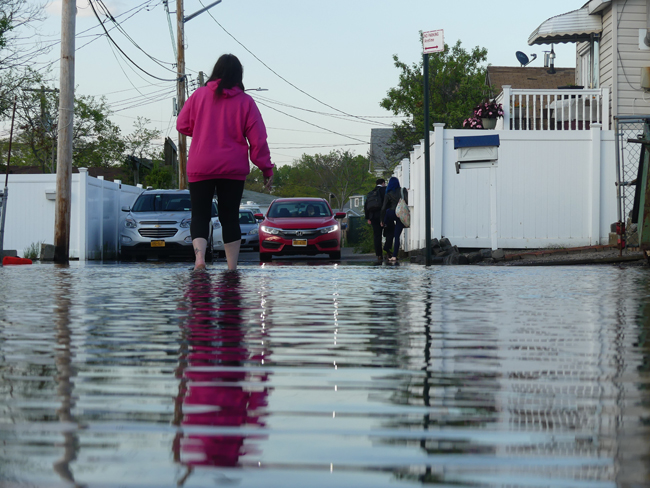
Flooding doesn't only happen on bad weather days. The phenomenon of “sunny day flooding” is just as it sounds–the weather may have been sunny, dry and calm for a week and yet the rising tide works its way up through storm drains, flooding the streets with seawater. The parking lot of the Howard Beach Motor Boat Club turned into a reflecting pool with several inches of seawater on the evening of May 15th, 2019, coincidental with a Flood Forum designed to provide resources for community members to prepare for the risks and challenges of coastal homeownership in the face of rising seas and a changing climate. The impact of the flooding was tangible as attendees removed shoes and socks to wade through the parking lot to the entrance. Credit: Ryan Strother / NYSG
Contact:
Katie Graziano, NYSG Coastal Resilience Extension Specialist, E: kag247@cornell.edu, P: 718-951-5415
There is no substitute for first-hand stories and on-the-ground experiences for understanding the impacts of coastal flooding
Brooklyn, NY, March 8, 2021 - For years, residents of New York City (NYC) have been noticing and raising awareness of high tide floods that are becoming deeper and more frequent. In low-lying neighborhoods, coastal flooding is regularly inundating local streets and properties. However, scientists, city officials and leaders lack comprehensive information on the impacts of flooding on daily lives in NYC.
New York Sea Grant (NYSG) worked with partnerships established through the Community Flood Watch Project to develop a first-of-its-kind pilot project to help neighborhood residents in NYC better understand the impacts of living with semi-regular flooding, how residents share information and take action on flooding, and what adaptation strategies the City and community can use to limit these impacts. The research team designed an interview process for use with residents in Hamilton/Howard Beach and Eastern Rockaway. These communities are often afflicted by “sunny day” high tide flooding (tidal vs. storm-based flooding).
Based on the results of interviews with residents’ the research team compiled a roster of social impacts from tidal flooding. The most common impacts were “emotional distress, frustration” and “miss or late for work, school, appointment”, followed by “property damage” and 10 more distinct impacts. Researchers noted that residents possess fine-tuned local knowledge of flooding and a connectedness to fellow community members. A Flood Watch Social Impacts Research Brief (www.nyseagrant.org/floodwatchsocialimpacts) with the results was created and broadly disseminated to community stakeholders, city agencies, and other stakeholders. As this is a pilot study, the findings are considered baseline data that can be used to track current conditions and measure future changes due to sea-level rise.
By interviewing residents to capture first-hand stories of local flooding, researchers created the first assessment of social impacts and adaptations to flooding around Jamaica Bay, New York City. As sea levels rise, this information will provide valuable insights on the social, economic and quality-of-life impacts of living with and adapting to flooding. Learn more about the Community Flood Watch Project at www.srijb.org/jbfloodwatch.
Project Partners:
• NYC Mayor’s Office of Resiliency
• Science and Resilience Institute at Jamaica Bay
• USDA Forest Service
More Info: New York Sea Grant
New York Sea Grant (NYSG), a cooperative program of Cornell University
and the State University of New York (SUNY), is one of 34 university-based
programs under the National Oceanic and Atmospheric Administration’s
National Sea Grant College Program.
Since 1971, NYSG has represented a statewide network of integrated
research, education and extension services promoting coastal community
economic vitality, environmental sustainability and citizen awareness
and understanding about the State’s marine and Great Lakes resources.
Through NYSG’s efforts, the combined talents of university scientists
and extension specialists help develop and transfer science-based
information to many coastal user groups—businesses and industries,
federal, state and local government decision-makers and agency managers,
educators, the media and the interested public.
The program maintains Great Lakes offices at Cornell University, SUNY
Buffalo, SUNY Oswego and the Wayne County Cooperative Extension office
in Newark. In the State's marine waters, NYSG has offices at Stony Brook
University in Long Island, Brooklyn College and Cornell Cooperative
Extension in NYC and Elmsford and Kingston in the Hudson Valley.
For updates on Sea Grant activities: www.nyseagrant.org has RSS, Facebook, Twitter, Instagram, and YouTube links. NYSG offers a free e-list sign up via www.nyseagrant.org/nycoastlines for its flagship publication, NY Coastlines/Currents, which is published quarterly.